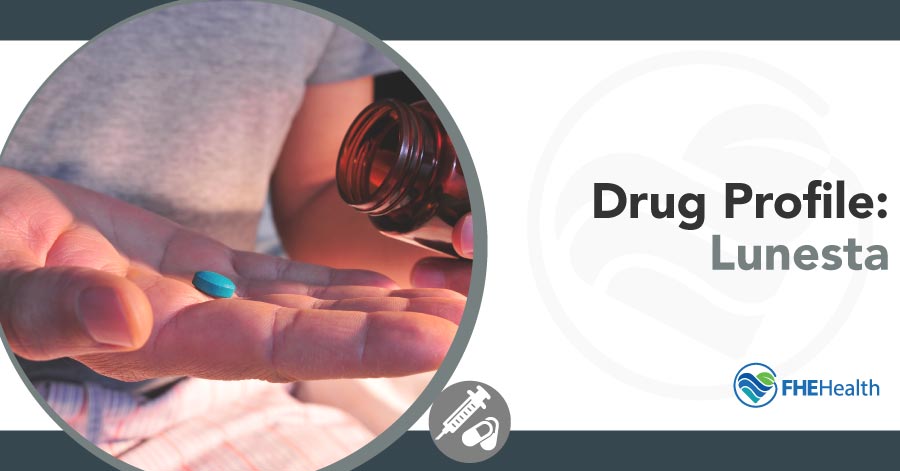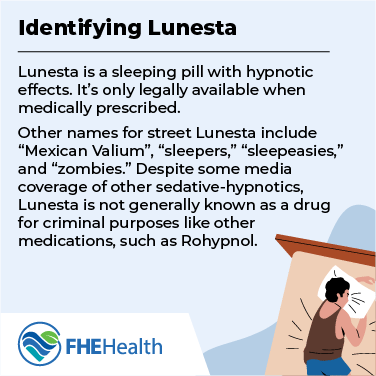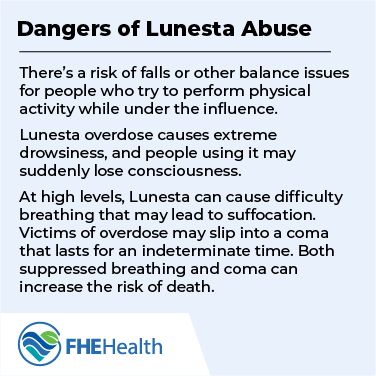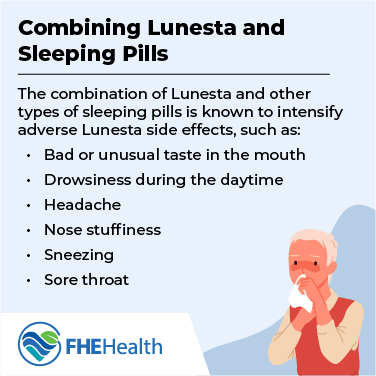
Getting enough sleep can be a challenge for many people. Up to 50 percent of American adults experience at least occasional inability to sleep, while roughly 10-15 percent of the public suffers from chronic insomnia. When sleep disorders like insomnia get in the way of your ability to function, your doctor might suggest a medical approach to the problem. For increasing numbers of people, the answer to insomnia is eszopiclone, which is offered under the brand name Lunesta.
Lunesta: What It Is
Lunesta is not an old-fashioned benzodiazepine-style sleeping pill. Instead, it belongs to a special class of drugs called sedative-hypnotics that act on the brain’s chemistry to produce a calming effect. Other drugs in this class include Ambien and Restoril.
Eszopiclone is not meant for long-term use. Because Lunesta’s side effects include a noticeable impact on alertness, cognition, and memory, the drug is not generally considered appropriate for more than two weeks of nightly or near-nightly use.
Identifying Lunesta
 Lunesta is a niche drug for individuals who use it illicitly. Because it is a sleeping pill with hypnotic effects, it’s only legally available when medically prescribed. Users sometimes buy medicine from street vendors. those vendors may have smuggled it into the United States from sources south of the U.S.-Mexican border. As a result, Lunesta is sometimes known as Mexican Valium.
Lunesta is a niche drug for individuals who use it illicitly. Because it is a sleeping pill with hypnotic effects, it’s only legally available when medically prescribed. Users sometimes buy medicine from street vendors. those vendors may have smuggled it into the United States from sources south of the U.S.-Mexican border. As a result, Lunesta is sometimes known as Mexican Valium.
Other names for street Lunesta include “sleepers,” “sleepeasies,” and “zombies.” Despite some media coverage of other sedative-hypnotics, Lunesta is not generally known as a drug for date rape or for other criminal purposes commonly associated with other medications, such as Rohypnol.
What Does Lunesta Do?
Lunesta is primarily a sleeping pill, a sedative-narcotic. Although the mechanism of how Lunesta works is unclear, it induces a dreaming, sleepy feeling in those who use it. After taking the tablet, many Lunesta users report they feel tired and develop the classic “Lunesta euphoria.” The euphoric feeling is short-lived, with sleep typically setting in within a few minutes.
Lunesta’s half-life is six hours. As a result, people using the drug who wake up before getting a whole night’s sleep can often feel groggy and disoriented. This is a tell-tale sign of Lunesta’s side effects. this also applies to problems with Lunesta (generic).
Addiction to Lunesta (Is Lunesta Addictive?)
Lunesta isn’t classically addictive in the way many of the more commonly abused street drugs are, though users can develop a chemical dependence. People who’ve started to become dependent on Lunesta may feel withdrawal symptoms that set in roughly 9-10 hours after the last dose has been taken.
People who abusively use Lunesta do so mainly for the euphoric state the drug induces shortly before sleep sets in. They may swallow one tablet for its long-term effect and follow up by snorting Lunesta for a quicker hit of the drug. Recreational users sometimes take a 2-3 mg dose of Lunesta with caffeine, amphetamines (meth, speed, crank), or other stimulants, including cocaine. The stimulants fight off sleep long enough for the user to fully experience the hypnotic euphoria and have a recreational high.
“Some substances or medications are referred to as habit-forming, rather than being chemically addictive. For those with sleep disorders they may get benefit from a medication like Lunesta and then develop a habit around taking it and to not take it creates anxiety as the patient believes they will not sleep without Lunesta, it can become a problem when trying to get off the medication,” shared Dr. Beau A. Nelson, DBH, LCSW, a clinician who has worked with sleep disorders and is Chief Clinical Officer at FHE Health, a behavioral health provider that uses an integrated care model combining medical, psychiatric, clinical and Neuroscience interventions to help sleep disorders and other mental health conditions.
Dangers of Lunesta Abuse
 The dangers of abusing Lunesta vary depending on the size of the dose that’s been taken, the user’s tolerance for the drug, and how long the person has spent taking the drug. Because sedative-hypnotics have a depressive effect on the central nervous system, there’s a danger a person using Lunesta may not be able to safely operate heavy machinery or drive. There’s also a risk of falls or other balance issues for people who try to walk or perform other physical activities while under the influence.
The dangers of abusing Lunesta vary depending on the size of the dose that’s been taken, the user’s tolerance for the drug, and how long the person has spent taking the drug. Because sedative-hypnotics have a depressive effect on the central nervous system, there’s a danger a person using Lunesta may not be able to safely operate heavy machinery or drive. There’s also a risk of falls or other balance issues for people who try to walk or perform other physical activities while under the influence.
More serious dangers develop when Lunesta is mixed with other drugs or when the amount consumed is higher than the prescribed dose. Lunesta overdose causes extreme drowsiness, and people using it may suddenly lose consciousness. At high levels, Lunesta can cause difficulty breathing, which may lead to suffocation. Victims of overdose may slip into a coma that lasts for an indeterminate time. Both suppressed breathing and coma can increase the risk of death.
Other Lunesta Side Effects
More severe dangers develop when Lunesta is mixed with other drugs or consumed at a higher dose than prescribed. Lunesta dosage overdose causes extreme drowsiness. People using it may suddenly lose consciousness.
At high levels, Lunesta side effects can cause difficulty breathing that may lead to suffocation. Overdose victims may slip into a coma that lasts indefinitely. Both suppressed breathing and coma can increase the risk of death. Severe allergic reactions are possible. Signs include hives, lips, tongue, throat, or face swelling, and difficulty breathing.
Lunesta and Older Adults
The sedative effects of Lunesta (and problems with Lunesta generic) may be more pronounced in older people. Elderly Lunesta users may be more prone to accidental injury and falls and should use caution when taking the medication. And, since older adults may be taking multiple prescription medications for various conditions, exercising caution is paramount.
Signs of Lunesta Abuse
In the short term, people who’ve been abusing Lunesta appear drowsy and possibly euphoric, and they may show visible signs of confusion. People using Lunesta frequently have memory trouble, and they may appear very forgetful or unable to recall old memories. The effect Lunesta has on memory can persist even several hours after the euphoria and drowsiness of the drug have worn off. Next-day withdrawal signs include jitteriness, irritability, and an inability to focus. Users in withdrawal experience strong cravings and may show drug-seeking behavior, such as complaining of insomnia or nonspecific pain.
Long-term abuse of Lunesta looks a lot like other kinds of sedative abuse. Chronic memory problems may become permanent with prolonged abuse, and heavy or frequent users may also have other drugs of choice, such as Ambien or Xanax. Advanced addiction to Lunesta can be associated with heavy use of opiates, notably heroin and oxycodone.
Identifying Someone Who Has Been Using Lunesta
Aside from the visible drowsiness and confusion a person may show when they’re under the influence of Lunesta, there are no infallible signs of use. Unless the person admits to having abused Lunesta or there’s other evidence, such as pill bottles or loose tablets, it may not be possible to establish with any certainty that Lunesta is the drug being used.
Common Lunesta Drug Combinations
Experienced drug users may mix Lunesta and other drugs to amplify the effects of the drug combination. Yet many people who combine potent drugs don’t understand the dangers of polydrug use.
Combining Lunesta and Sleeping Pills
 The combination of Lunesta and other types of sleeping pills is known to intensify adverse Lunesta side effects. Some of the adverse effects reported include:
The combination of Lunesta and other types of sleeping pills is known to intensify adverse Lunesta side effects. Some of the adverse effects reported include:
- Bad or unusual taste in the mouth
- Drowsiness during the daytime
- Headache
- Nose stuffiness
- Sneezing
- Sore throat
Lunesta users may experience frequent hypnotic and sleep-inducing Lunesta side effects. As one of the sedative’s adverse effects, daytime drowsiness can negatively affect performance at work, the ability to drive safely, and situations requiring concentration and focus.
Mixing Lunesta with other types of prescription drugs may also damage the user’s organ systems, including the kidneys, liver, and brain.
Combining Lunesta and Alcohol
Lunesta is a central nervous system depressant. So is alcohol. Mixing Lunesta and alcohol is particularly dangerous because it can increase the drug’s sedating effects. This may cause difficulties with concentration, dizziness, drowsiness, and faulty judgment.
In addition, Lunesta users who binge drink can experience plummeting blood pressure. They may also have difficulty breathing.
Overdose Risk
While Lunesta users may be drawn to combining the sedative with other drugs, this increases their risk of overdose. Polydrug use overdose can prove fatal.
Identifying Someone Who Has Been Using Lunesta
Aside from the visible drowsiness and confusion a person may show when under the influence of Lunesta, there are no infallible signs of use. Unless the person admits to having abused Lunesta or other evidence, such as pill bottles or loose tablets, is found, it may not be possible to establish with certainty that Lunesta is the drug they used.
Professional Treatment for Lunesta Addiction
Because of the powerful psychoactive effects Lunesta can have on the people who use it, detoxing from chronic use at home may not be safe. As a rule, half the Lunesta in a person’s body will have been flushed or metabolized within the first 9-10 hours, with another quarter gone by the end of the first full day without use. This is usually a period of severe cravings, and an unsupervised detoxification could easily slip into relapse or acute medical issues such as racing heartbeat and hallucinations.
Why Supervised Detox Is Essential
For these reasons, doctors who treat sedative addiction generally recommend detoxing in a safe and supervised environment, which may be a clinic or hospital setting. This incidentally gives the medical team a chance to take a person’s medical and drug use history, identify any comorbid medical conditions, and schedule physical and mental health interventions if needed. During the initial detox, the team can administer necessary medications to help manage cravings and the anxiety that goes with Lunesta withdrawal, as well as watch for signs of serious complications that may arise.
Transitioning to Outpatient Treatment
After the first few days, many former users of Lunesta can go home, though the treatment for addiction has only just begun. Using an outpatient or hybrid inpatient/outpatient model for direct addiction therapy, the rehab specialists can guide a Lunesta user through the first stages of long-term sobriety. The goal of this stage of treatment is to ease the person into a group setting with other people who’ve abused sedatives and promote an abstinence-based recovery. The continuing treatment for Lunesta abuse is similar to the long-term maintenance of other addictive disorders: Former users pair off with a sponsor and attend regular meetings to discuss sobriety, with the goal of a lifelong remission from abusive drug use.
The continuing treatment for Lunesta abuse is similar to the long-term maintenance of other addictive disorders. Former users pair off with a sponsor and attend regular meetings to discuss sobriety with the goal of lifelong remission.
Take the First Step Toward Recovery from Lunesta Abuse
If you’ve been misusing Lunesta or are concerned that someone you care for has been using it abusively, it’s time to call for help. Contact us today by calling FHE Health at (877) 594-3566. Our compassionate team of counselors is standing by to take your call 24/7. Start your journey to recovery today.






